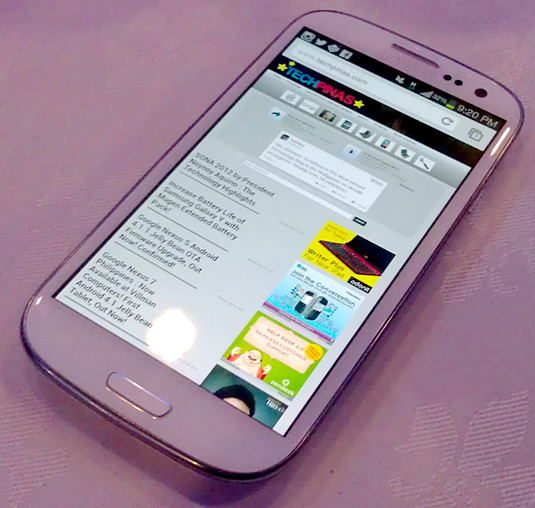How to Increase Battery Life of Samsung Galaxy S3 GT-i9300 and Similar Smartphones in Seven Easy Steps!
Samsung's 2012 flagship Android smartphone, Samsung Galaxy S3, already has a rather sizable 2100 mAh Li-ion battery pack, which is said to deliver around 5 hours of web browsing, 10 hours of talk time, or 10 hours of video playback.

But if you're hardly satisfied with the handset's uptime, here are seven very easy steps that you can take to further improve your Samsung Galaxy S3's battery life:
(Oh, and these will also work for any Samsung Galaxy smartphone, including Samsung Galaxy S, S2, Ace, Ace Plus, Y, Y Duos, Pocket, Wonder, and Samsung Galaxy Note, among others.)
1. Turn on Power Saving - You can do this simply by swiping down on the notifications tab and clicking on the Power Saving box in the upper right corner. This mode underclocks the CPU to around 800 MHz to 1 GHz resulting in a slight decrease in the phone's overall performance; The most noticeable effect of which is slower screen refresh rate.

2. Turn off Automatic Brightness and Set Screen Brightness to Zero - If there's one part of any full touchscreen phone that affects its battery life the most, it would have to be the display. And the brighter it is, the more energy it consumes. So to augment the uptime, I would suggest that you set your S3 screen's brightness to zero by going to Settings, Display, then Brightness. Just untick the Automatic brightness box and slide Brightness down to zero. Anyway, when you're at home or in the office, SuperAMOLED Plus even at zero brightness will still look bright and readable.
Take it a step further: If you want to further dim the screen, you can download Screen Filter app from Google Play. This app applies a shade to the display that acts as a dimmer, helping prolong battery life while making the screen easier on the eyes during night-time viewing.
3. Disable Interactive Home Screen Widgets - While some of them actually look cute, these widgets - especially those that refresh and use connectivity regularly - can eat up your battery just like that. To remove interactive widgets from the home screen, just long press on them, then click delete or swipe them up and off the edge of the display.
4. Turn off WiFi, Bluetooth, GPS, and Mobile Data Connection if you don't need them - Just like when conserving water or electricity (i.e. turn off the faucet and unplug appliances if you don't need them), disable your phone's connectivity options if you're not using them. You can easily disable WiFi, Bluetooth and GPS via the notifications tab, while you need to go to Settings to turn off Mobile Data. You can also use Samsung's static Power Saving widget or download one from Google Play to help you manage your connections straight from the home screen.
5. Turn off Notifications and Close Apps After Using Them - There are a lot of applications for Android - especially those for social networking - that when launched and left running in the background continue to use connectivity and update even if you're not viewing them. The first thing I would suggest you do is to turn off notifications for every app you download (unless you really need to get notified regularly). You can do this by going to the apps' settings and unticking the notifications box. Second, remember to close apps after you use them. On ICS, this is as simple as long pressing the home button to view thumbnails of all recent apps and swiping those you want to close either to the left or to the right. (For other Galaxy phone users: If you're still on Gingerbread, just click on the Menu button while running the app and click close or exit.)
6. Disable Vibrate and Haptic Feedback - Again, this is another 'turned on by default' feature that you might want to disable to save battery. To turn off Vibration, just go to Settings, Sound, and Set Vibration Intensity for Ringtone, Notification, and Vibrate on Screen Tap to zero. This will also disable haptic feedback when using any virtual keyboard -- even third party ones like SwiftKey or Go Keyboard.
7. Turn off Account Sync - Regular account sync for Social Hub, Google, Skype, Facebook, Twitter, and other apps - even when just in the background - uses connectivity and other services. To disable this, just go to Settings, Accounts and Sync and make sure that the tab in the upper right corner is switched off.
There you go, TP Friends. I hope you find this list useful. Now, if you will, kindly share this post with other Samsung Galaxy smartphone users on Facebook and Twitter.

But if you're hardly satisfied with the handset's uptime, here are seven very easy steps that you can take to further improve your Samsung Galaxy S3's battery life:
(Oh, and these will also work for any Samsung Galaxy smartphone, including Samsung Galaxy S, S2, Ace, Ace Plus, Y, Y Duos, Pocket, Wonder, and Samsung Galaxy Note, among others.)
1. Turn on Power Saving - You can do this simply by swiping down on the notifications tab and clicking on the Power Saving box in the upper right corner. This mode underclocks the CPU to around 800 MHz to 1 GHz resulting in a slight decrease in the phone's overall performance; The most noticeable effect of which is slower screen refresh rate.

2. Turn off Automatic Brightness and Set Screen Brightness to Zero - If there's one part of any full touchscreen phone that affects its battery life the most, it would have to be the display. And the brighter it is, the more energy it consumes. So to augment the uptime, I would suggest that you set your S3 screen's brightness to zero by going to Settings, Display, then Brightness. Just untick the Automatic brightness box and slide Brightness down to zero. Anyway, when you're at home or in the office, SuperAMOLED Plus even at zero brightness will still look bright and readable.
Take it a step further: If you want to further dim the screen, you can download Screen Filter app from Google Play. This app applies a shade to the display that acts as a dimmer, helping prolong battery life while making the screen easier on the eyes during night-time viewing.
3. Disable Interactive Home Screen Widgets - While some of them actually look cute, these widgets - especially those that refresh and use connectivity regularly - can eat up your battery just like that. To remove interactive widgets from the home screen, just long press on them, then click delete or swipe them up and off the edge of the display.
4. Turn off WiFi, Bluetooth, GPS, and Mobile Data Connection if you don't need them - Just like when conserving water or electricity (i.e. turn off the faucet and unplug appliances if you don't need them), disable your phone's connectivity options if you're not using them. You can easily disable WiFi, Bluetooth and GPS via the notifications tab, while you need to go to Settings to turn off Mobile Data. You can also use Samsung's static Power Saving widget or download one from Google Play to help you manage your connections straight from the home screen.
5. Turn off Notifications and Close Apps After Using Them - There are a lot of applications for Android - especially those for social networking - that when launched and left running in the background continue to use connectivity and update even if you're not viewing them. The first thing I would suggest you do is to turn off notifications for every app you download (unless you really need to get notified regularly). You can do this by going to the apps' settings and unticking the notifications box. Second, remember to close apps after you use them. On ICS, this is as simple as long pressing the home button to view thumbnails of all recent apps and swiping those you want to close either to the left or to the right. (For other Galaxy phone users: If you're still on Gingerbread, just click on the Menu button while running the app and click close or exit.)
6. Disable Vibrate and Haptic Feedback - Again, this is another 'turned on by default' feature that you might want to disable to save battery. To turn off Vibration, just go to Settings, Sound, and Set Vibration Intensity for Ringtone, Notification, and Vibrate on Screen Tap to zero. This will also disable haptic feedback when using any virtual keyboard -- even third party ones like SwiftKey or Go Keyboard.
7. Turn off Account Sync - Regular account sync for Social Hub, Google, Skype, Facebook, Twitter, and other apps - even when just in the background - uses connectivity and other services. To disable this, just go to Settings, Accounts and Sync and make sure that the tab in the upper right corner is switched off.
There you go, TP Friends. I hope you find this list useful. Now, if you will, kindly share this post with other Samsung Galaxy smartphone users on Facebook and Twitter.
Labels:
Cellphone
Featured
Samsung
Samsung Galaxy S3 GT-i9300
Samsung Galaxy S3 Philippines
Tech Basics



.jpg)
No comments:
Let me know your thoughts on this TechPinas article.